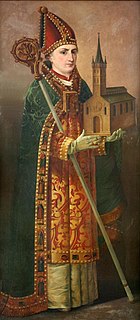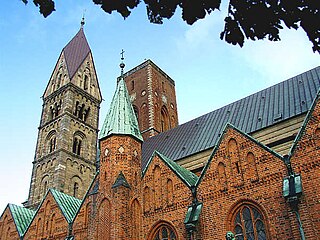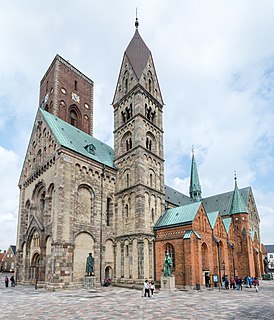Related Research Articles

Ansgar, also known as Anskar, Saint Ansgar, Saint Anschar or Oscar, was Archbishop of Hamburg-Bremen in the northern part of the Kingdom of the East Franks. Ansgar became known as the "Apostle of the North" because of his travels and the See of Hamburg received the missionary mandate to bring Christianity to Northern Europe.

Sweyn II Estridsson Ulfsson was King of Denmark from 1047 until his death in 1076. He was the son of Ulf Thorgilsson and Estrid Svendsdatter, and the grandson of King Sweyn I Forkbeard through his mother's line. He was married three times, and fathered 20 children or more out of wedlock, including the five future kings Harald III Hen, Canute IV the Saint, Oluf I Hunger, Eric I Evergood, and Niels.
Nidaros, Niðarós or Niðaróss was the medieval name of Trondheim when it was the capital of Norway's first Christian kings. It was named for its position at the mouth of the River Nid.

Thomas of Bayeux was Archbishop of York from 1070 until 1100. He was educated at Liège and became a royal chaplain to Duke William of Normandy, who later became King William I of England. After the Norman Conquest, the king nominated Thomas to succeed Ealdred as Archbishop of York. After Thomas' election, Lanfranc, Archbishop of Canterbury, demanded an oath from Thomas to obey him and any future Archbishops of Canterbury; this was part of Lanfranc's claim that Canterbury was the primary bishopric, and its holder the head of the English Church. Thomas countered that York had never made such an oath. As a result, Lanfranc refused to consecrate him. The King eventually persuaded Thomas to submit, but Thomas and Lanfranc continued to clash over ecclesiastical issues, including the primacy of Canterbury, which dioceses belonged to the province of York, and the question of how York's obedience to Canterbury would be expressed.

Aarhus Cathedral is a cathedral in Aarhus, Denmark. It is the longest and tallest church in the country, at 93 m (305 ft) in length and 96 m (315 ft) in height.

The former Diocese of Aarhus was a Roman Catholic diocese in Denmark, founded in the 10th century and dissolved during the Protestant Reformation. The diocese included the counties of Aarhus and Randers, the islands of Samsø and Tunø, and, after 1396, part of the county of Viborg.

The Diocese of Lund is a diocese within the Church of Sweden which corresponds to the provinces of Blekinge and Skåne. There are 217 parishes within the diocese, the most significant number in any of the dioceses of the Church of Sweden. The present bishop of Lund, Johan Tyrberg, succeeded Antje Jackelén in 2014.

The Diocese of Chichester is a Church of England diocese based in Chichester, covering Sussex. It was founded in 681 as the ancient Diocese of Selsey, which was based at Selsey Abbey, until the see was translated to Chichester in 1075. The cathedral is Chichester Cathedral and the diocesan bishop is the Bishop of Chichester. The diocese is in the Province of Canterbury.

The Church of Our Lady is one of the larger church structures of Århus, Denmark. It is situated in the centre of the city not far from Aarhus Cathedral. The church and associated structures were built in several stages in the coarse of the Middle Ages, from the late 1200s to 1500 AD. The original church at the site, stood finished as early as 1060 AD, but only the stone crypt remains today as evidence of its existence.

The former Diocese of Børglum was a Roman Catholic diocese in Northern Jutland, Denmark. It has also been referred to as the Diocese of Vestervig or the Bishopric of Vendsyssel. The diocese included Vendsyssel, Hanherred, Thy, and Mors.

The Christianization of Scandinavia, as well as other Nordic countries and the Baltic countries, took place between the 8th and the 12th centuries. The realms of Denmark, Norway and Sweden established their own Archdioceses, responsible directly to the Pope, in 1104, 1154 and 1164, respectively. The conversion to Christianity of the Scandinavian people required more time, since it took additional efforts to establish a network of churches.

The former Diocese of Ribe was a Roman Catholic diocese in Southern Jutland, Denmark. The diocese was established in 948, and dissolved in 1536 during the Protestant Reformation. Within the newly established protestant Church of Denmark, the Diocese of Ribe effectively replaced its Roman Catholic precursor.

Ribe Cathedral or Our Lady Maria Cathedral is located in the ancient city of Ribe, on the west coast of southern Jutland, Denmark. It was founded in the Viking Era as the first Christian church in Denmark by Ansgar, a missionary monk from Hamburg, under permission of the pagan King Horik I. The cathedral has experienced several damaging events throughout its long history and has been restored, expanded and decorated repeatedly. As it stands today, Ribe Cathedral is the best preserved Romanesque building in Denmark, but reflects a plethora of different architectural styles and artistic traditions. It ranks among the most popular tourist attractions in Denmark and has been awarded two stars in the Michelin guide.

The Diocese of Aarhus is one of 10 diocese in the Church of Denmark, with headquarters in the city of Aarhus. The diocese covers a large district of northeast Jutland and comprise 14 deaneries, of which four cover the extent of Aarhus city itself.

The Archdiocese of Nidaros was the metropolitan see covering Norway in the later Middle Ages. The see was the Nidaros Cathedral, in the city of Nidaros. The archdiocese existed from the middle of the twelfth century until the Protestant Reformation.

Our Lady's Priory, Aarhus was an early Dominican foundation just outside the original walls of Aarhus, Denmark. The buildings are part of the Church of Our Lady complex, now part of the inner city of Aarhus, but they have been repurposed.
The following is a timeline of the history of the city of Aarhus, Central Denmark Region, Denmark.
The history of Christianity in Denmark started with Saint Willibrord's unsuccessful mission among the Danes in the early 8th century.
Reginbrand was a bishop of the Ancient See of Aarhus. He was ordained by bishop Adaldag of Hamburg-Bremen in 948 in the first ordination of bishops in the Scandinavian countries. The ordination had the explicit support of the pope who wished to expand Christianity into northern Europe. Adaldag ordained three bishops for the Jutland region; Harald to Slesvig, Ljufdag to Ribe and Reginbrand to Aarhus. The meeting was attended by Otto the Great and Louis IV along with 34 German, French and Danish bishops, in the St. Remigius Kirche in Ingelheim am Rhein.
References
- ↑ "Bisperækken i Aarhus Stit" (in Danish). Diocese of Aarhus. Archived from the original on 12 October 2016. Retrieved 20 September 2016.
- ↑ "Årstal i Aarhus' Historie" (in Danish). Aarhus City Archives. Archived from the original on 2016-09-29. Retrieved 20 September 2016.
- ↑ "Aarhus Domkirke" (in Danish). Aarhus Cathedral. Archived from the original on 2016-10-02. Retrieved 20 September 2016.